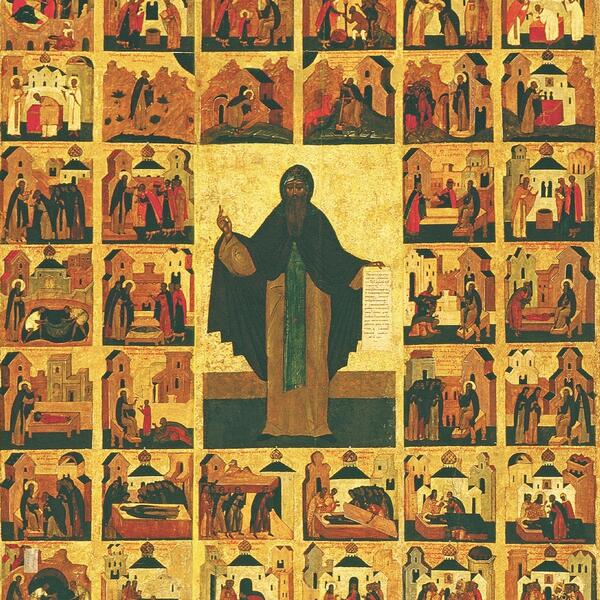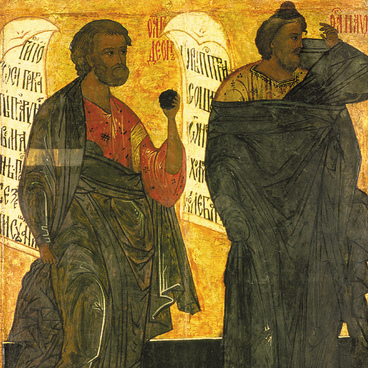Venerable Barlaam of Khutyn is one of the most popular Novgorod saints who was known for his gentleness, kindness, and humility, and also for receiving from God the gifts of astuteness and wonderworking.
Barlaam was born as Aleksey in the 12th century. His parents were wealthy and devout people, while the saint preferred the life of religion since early childhood. When his parents tried to convince the boy to give up strict fasting, he reproached them, saying that only those who pleased God and suffered for him could enter the Kingdom of Heaven and that he would like to follow their example.
As a young man, Aleksey gave away his possessions, took the monastic vows under the name of Barlaam in the Lisichy Monastery, and later lived as a hermit at the Khutyn Hill. This hill was infamously known for being an “evil place”, but the demons were powerless against his faith. He spent all the time working, fasting, and praying, wore fetters, built himself a cell, and received visitors. In 1192, seeing that many people were eager to stay with him, Saint Barlaam built a wooden church and later founded the Transfiguration Monastery, serving as its hegumen.
The oldest Russian legal document is the parchment paper in which Saint Barlaam transferred his lands, including croplands and hay lands to the monastery.
In the 13th century, Barlaam of Khutyn became a venerated saint in Novgorod, and in the 15th century, he became celebrated throughout Russia. Most likely, his popularity increased after Grigory, a gentleman of the bedchamber of Vasily the Blind, was healed at the coffin of Barlaam. Even after his death, the saint kept praying for the Novgorod land, and also foretold the plague and fire in Novgorod.
Over ten versions of Saint Barlaam’s hagiography were written in the period between the 13th and the 18th century, including the “Panegyric” by Pachomius the Logothetes, the 1526 “extensive” version, and the “special” version created in the second half of the 16th century. The saint was canonized by the Sobor in 1547.
The centerpiece with the image of Barlaam of Khutyn is surrounded by 36 border scenes depicting his life and miracles. These include the prophecy that Prince Yaroslav will have a son, the resurrection of a young man, and the miracles of healing at the saint’s relics. The last two border scenes are very rare. They depict the miracles performed by Barlaam after his death: sunmaking during rain and rainmaking during a drought.
In the border scenes, the artist depicted small details, including the wooden boards of a disabled man who had come to beg for alms, and the letters in the scene where Barlaam learns to read.
Most likely, the icon was originally placed in the wooden church of Elijah the Prophet. A stone church was built in its place by the Skripin merchants in 1650.
Barlaam was born as Aleksey in the 12th century. His parents were wealthy and devout people, while the saint preferred the life of religion since early childhood. When his parents tried to convince the boy to give up strict fasting, he reproached them, saying that only those who pleased God and suffered for him could enter the Kingdom of Heaven and that he would like to follow their example.
As a young man, Aleksey gave away his possessions, took the monastic vows under the name of Barlaam in the Lisichy Monastery, and later lived as a hermit at the Khutyn Hill. This hill was infamously known for being an “evil place”, but the demons were powerless against his faith. He spent all the time working, fasting, and praying, wore fetters, built himself a cell, and received visitors. In 1192, seeing that many people were eager to stay with him, Saint Barlaam built a wooden church and later founded the Transfiguration Monastery, serving as its hegumen.
The oldest Russian legal document is the parchment paper in which Saint Barlaam transferred his lands, including croplands and hay lands to the monastery.
In the 13th century, Barlaam of Khutyn became a venerated saint in Novgorod, and in the 15th century, he became celebrated throughout Russia. Most likely, his popularity increased after Grigory, a gentleman of the bedchamber of Vasily the Blind, was healed at the coffin of Barlaam. Even after his death, the saint kept praying for the Novgorod land, and also foretold the plague and fire in Novgorod.
Over ten versions of Saint Barlaam’s hagiography were written in the period between the 13th and the 18th century, including the “Panegyric” by Pachomius the Logothetes, the 1526 “extensive” version, and the “special” version created in the second half of the 16th century. The saint was canonized by the Sobor in 1547.
The centerpiece with the image of Barlaam of Khutyn is surrounded by 36 border scenes depicting his life and miracles. These include the prophecy that Prince Yaroslav will have a son, the resurrection of a young man, and the miracles of healing at the saint’s relics. The last two border scenes are very rare. They depict the miracles performed by Barlaam after his death: sunmaking during rain and rainmaking during a drought.
In the border scenes, the artist depicted small details, including the wooden boards of a disabled man who had come to beg for alms, and the letters in the scene where Barlaam learns to read.
Most likely, the icon was originally placed in the wooden church of Elijah the Prophet. A stone church was built in its place by the Skripin merchants in 1650.



